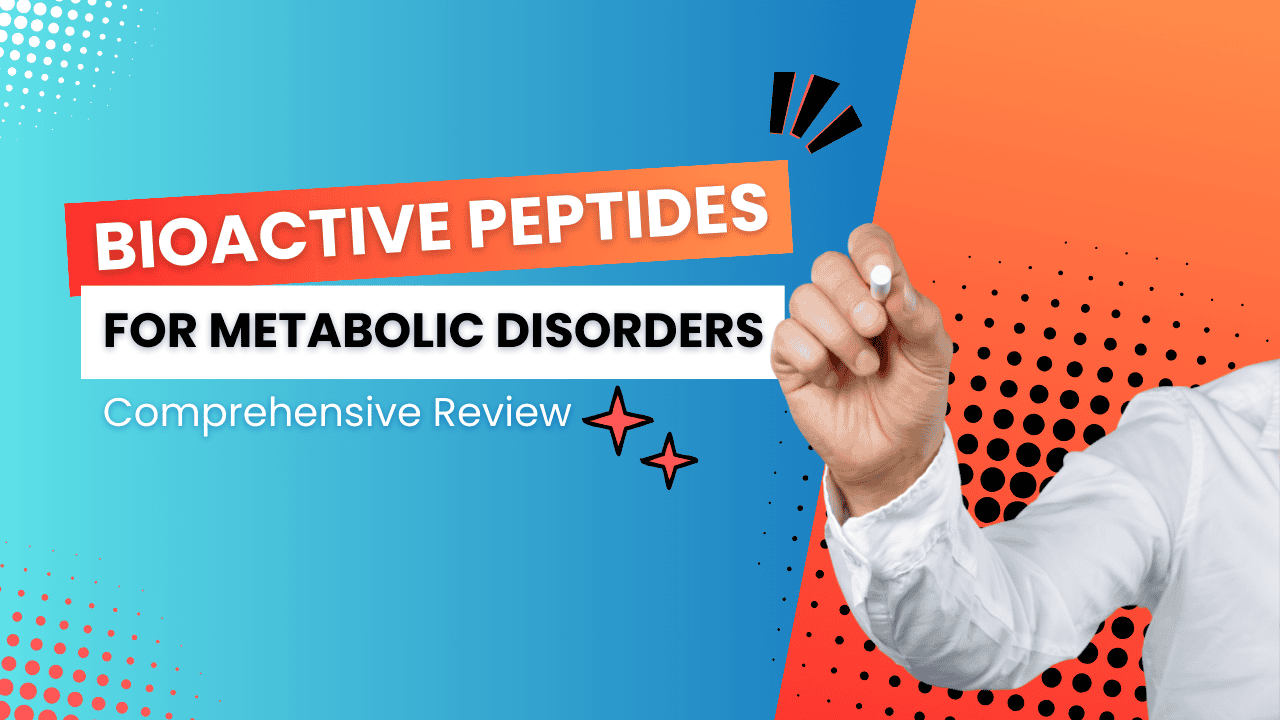

Navigating the complexities of neurodegenerative disorders can feel like searching for a needle in a haystack.
This article delves into peptide therapeutics as a potential beacon of hope for these challenging conditions.
Peptides, with their unique molecular properties, are making waves in the treatment of neurodegenerative disorders, giving us a fresh perspective on battling diseases like Alzheimer’s and Parkinson’s.
Neurodegenerative disorders are tragic tales of progressive neuronal decline. These diseases disrupt the delicate balance of our central nervous system, leading to the slow deterioration of cognitive and motor functions. Imagine losing your ability to remember loved ones or even the simplest joys—heart-wrenching, right?
These disorders often develop due to misfolded proteins aggregating in the brain. Think of it as a broken record, where proteins and peptides like amyloid-beta form clumps that meddle with normal brain functions. The exact pathways remain a mystery, but oxidative stress, mitochondrial dysfunction, and genetic mutations play key roles.
Alzheimer’s Disease: Marked by the infamous plaques and tangles of amyloid-beta and tau proteins.
Parkinson’s Disease: Characterized by the degeneration of dopamine-producing neurons.
ALS (Amyotrophic Lateral Sclerosis): A progressive disease affecting motor neurons.
Huntington’s Disease: A genetic disorder leading to motor dysfunction and cognitive decline.
The exact science behind these diseases remains elusive, but risk factors include aging, genetics, environmental toxins, and lifestyle choices. Consider it a cocktail of misfortune, where some elements are beyond our control, while others, like diet and exercise, are within our grasp.
Symptoms vary but often start subtly—slight memory lapses or tremors—before snowballing into severe cognitive impairments and physical disabilities. Diagnosis typically involves neuroimaging, cognitive tests, and sometimes, tandem mass spectrometry to detect biomarkers.
Peptides play an essential role by interfering with pathological processes at the molecular level. These bioactive molecules can inhibit the aggregation of toxic proteins, reduce oxidative stress, and even promote neuronal growth and repair.
Therapeutic peptides are small chains of amino acids designed to target specific pathways and mitigate disease progression. They’re like precision tools in a mechanic’s kit, tailored to fix intricate issues without causing extensive collateral damage.
These peptides can:
Inhibit enzyme activity responsible for protein aggregation.
Target mutant proteins directly.
Enhance neuroprotective and antiinflammatory responses.
Act as growth factors to promote cell survival and regeneration.
Peptides offer high specificity with low molecular weight, allowing them to cross the blood-brain barrier more effectively than larger protein-based drugs. Think of them as nimble acrobats navigating through a densely packed circus.
Despite their promise, peptides may have moved permanently to a new web of challenges like rapid degradation and short half-lives, making it essential to develop more stable peptide formulations.
Alzheimer’s disease, a prime culprit behind dementia, is marked by amyloid-beta plaques. Peptides targeting this pathway can potentially slow down or even reverse cognitive decline.
ADDLs (Amyloid-beta Derived Diffusible Ligands): These synthetic peptides inhibit amyloid-beta aggregation.
Active Peptides: Designed to disrupt tau protein tangles.
They work by binding to amyloid-beta, preventing its toxic accumulation in the brain, much like a sponge soaking up spilled milk before it stains.
Clinical trials have shown that peptide inhibitors significantly reduce amyloid plaque load in the brains of mice, translating into improved memory and cognitive functions. It’s hopeful terrain after a long drought.
The future looks bright, with ongoing research focusing on refining peptide sequences to increase stability and enhance brain penetration, opening new vistas in Alzheimer’s therapeutics.
Parkinson’s disease involves the degradation of dopaminergic neurons. Peptides regulating mitochondrial function and oxidative stress can protect these neurons, offering a lifeline in the fog of disease progression.
DJ-1 Peptide: Targets oxidative stress in neurons.
NAC (N-Acetyl Cysteine): Provides neuroprotective effects by boosting intracellular glutathione levels.
Preclinical studies indicate that these peptides could reduce motor symptoms and slow disease progression, holding promise for a better quality of life.
Researchers are exploring peptides isolated from neurotrophic factors to regenerate damaged neurons and restore motor functions.
Exciting developments include the engineering of peptides derived from various proteins to enhance neuroprotection and delivery methods like nanoparticle-based systems to improve peptide stability.
Novel peptides are newly discovered or engineered molecules designed with specific therapeutic targets in mind, pushing the boundaries of conventional treatments.
These peptides are often synthesized through advanced molecular techniques, tailored to target key pathological processes within cells.
NRF2-Activating Peptides: These peptides play a role in reducing oxidative stress and inflammation.
Peptide-Based Vaccines: Targeting mutant proteins to prevent their pathological aggregation.
These novel peptides show promise in slowing neurodegenerative processes and protecting neuronal integrity, potentially revolutionizing treatment paradigms.
Peptides can enhance synaptic plasticity and promote neuronal survival, effectively countering cognitive impairment. Imagine a gardener pruning plants to encourage robust growth—peptides do something similar at the neuronal level.
BDNF (Brain-Derived Neurotrophic Factor) Peptides: Support the survival and differentiation of neurons.
IGF-1 (Insulin-Like Growth Factor-1) Peptides: Enhance cognitive functions by promoting neurogenesis.
Several clinical trials are underway, assessing the potential of these peptides to improve memory and cognitive functions in patients with dementia and mild cognitive impairment.
Innovation in peptide formulations and delivery methods, such as nasal sprays and liposomal encapsulations, promises more effective interventions for cognitive decline.
Neuroprotective effects refer to the ability of substances to preserve neuronal structure and function, shielding them from degeneration.
Dipeptide mimetics: Target oxidative stress pathways.
Neurotrophic Factor Peptides: Encourage neuronal growth and resilience against stressors.
These peptides work by binding to receptors on neurons, activating signaling pathways that combat cell death and promote survival. It’s like sending in reinforcements during a battle.
Studies in vitro and in vivo consistently demonstrate that peptide treatments can significantly reduce neuronal death and improve functional outcomes in models of neurodegenerative diseases.
Research is focusing on improving peptide stability and targeting, using innovative delivery mechanisms to maximize their therapeutic potential.
These peptides are designed to block the activity of specific proteins, enzymes, or pathways that contribute to neurodegeneration—a bit like turning off a leaky faucet at its source.
Inhibitor peptides can prevent protein aggregation, modulate inflammatory responses, and inhibit toxic enzyme activity. These actions help preserve neuronal health and function.
Aβ Inhibitors: Target amyloid-beta aggregation in Alzheimer’s.
α-Synuclein Inhibitors: Prevent protein aggregation in Parkinson’s.
One of the main hurdles lies in ensuring these peptides are stable and can reach their target tissues without being degraded, requiring sophisticated delivery systems.
Several peptides have shown great promise in addressing key pathological features of neurodegenerative diseases. Examples include amyloid-beta inhibitors, tau protein regulators, and neurotrophic factor mimetics.
These peptides are being integrated into treatment regimens either as standalone therapies or in combination with other drugs, aiming to halt disease progression and improve patient outcomes.
Case studies illustrate dramatic improvements in cognitive functions and motor skills, providing hope for broader applications of peptide-based therapeutics in clinical settings.
Peptides interact with cellular receptors or proteins, modulating key signaling pathways and transcription factors to achieve their therapeutic effects. It’s all about precision-targeted action at the molecular level.
Inhibition of Protein Aggregation: Prevents the formation of toxic aggregates.
Activation of Neuroprotective Pathways: Enhances cellular resilience.
Recent research has unveiled how specific peptides can rewire cellular pathways, providing nuanced insights into their mechanisms, paving the way for fine-tuning therapeutic approaches.
From discovery and design to preclinical and clinical trials, peptide development involves rigorous testing to ensure safety, efficacy, and stability—much like crafting a masterpiece from raw stone.
Peptides are typically tested in vitro before moving on to animal models and ultimately human clinical trials. Each step scrutinizes their bioactivity, safety, and pharmacokinetics.
The journey through clinical trials involves multiple phases, from small-scale studies on safety (Phase 1) to large-scale efficacy trials (Phase 3), ensuring comprehensive evaluation before approval.
Challenges include peptide stability, delivery, and potential immunogenicity. Developing solutions for these issues is essential for their successful clinical application.
Innovative strategies like peptide modification, advanced delivery systems, and co-administration with stabilizing agents are being explored to enhance peptide effectiveness.
Cutting-edge technologies such as nanoparticle carriers and CRISPR-based techniques are paving the way for more efficient and targeted peptide therapeutics, bringing hope to millions.
Conflicts of interest may arise when researchers have financial ties to organizations funding their studies, potentially biasing the results.
Such conflicts can skew data interpretation and undermine trust in research findings, making transparency and ethical guidelines crucial.
Implementing robust ethical standards and disclosing financial interests are key steps in maintaining research integrity, ensuring findings are credible and trustworthy.
GLP-1 Analogues for Alzheimer’s: These peptides have shown promise in reducing amyloid plaque burden.
Neurotrophic Factor Mimetics in ALS: These peptides have improved motor functions and prolonged survival in animal models.
Long-term studies indicate sustained benefits, such as improved cognitive functions and motor control, validating the potential of peptide-based treatments for chronic conditions.
These case studies underline the importance of personalized approaches and the need to fine-tune peptide formulations to maximize their therapeutic potential.
Recent trends include the development of multifunctional peptides, combining neuroprotective and neuroregenerative properties, offering a multi-pronged approach to treatment.
New peptide formulations, targeting previously unaddressed pathways, hold promise for more effective interventions. The horizon is bright with possibilities.
In the next ten years, we can expect breakthroughs in peptide stability, delivery systems, and personalized medicine, revolutionizing how we approach neurodegenerative diseases.
Molecular techniques like CRISPR and next-generation sequencing aid in designing peptides with precision, ensuring they target the right pathways without unintended effects.
These approaches allow for the fine-tuning of peptide structures, enhancing their stability, specificity, and bioavailability, ultimately leading to more effective treatments.
Combining molecular techniques with peptide therapies opens new avenues for synergistic treatments, amplifying the therapeutic effects and offering a comprehensive approach to neurodegenerative disorders.
Ethical concerns revolve around patient safety, informed consent, and potential long-term impacts of new treatments, requiring meticulous oversight and ethical rigor.
Researchers adhere to strict ethical guidelines, ensuring transparency, patient welfare, and unbiased reporting of results, maintaining the integrity of scientific inquiry.
Balancing the drive for innovation with ethical considerations ensures peptide research progresses responsibly, safeguarding patient interests and societal trust.
Regulatory bodies like the FDA and EMA oversee the approval of peptide drugs, ensuring they meet safety, efficacy, and quality standards through rigorous evaluation processes.
These bodies set guidelines for clinical trials, monitor adverse effects, and oversee manufacturing practices, ensuring peptides reach patients safely and effectively.
Navigating regulatory pathways requires comprehensive documentation and adherence to guidelines, a meticulous process essential for bringing peptides from the lab to the clinic.
Patients often view peptide therapies with hope, seeing them as promising alternatives to traditional treatments, especially when other options have failed.
Many patients report improvements in symptoms and quality of life, validating the potential benefits of peptide therapies and encouraging ongoing research.
Patient feedback is crucial for refining treatments, ensuring they address real-world needs and concerns, ultimately enhancing their effectiveness and acceptance.
Computational tools model peptide interactions with target proteins, predicting their efficacy and stability before synthesis, streamlining the development process.
Tools like molecular docking simulations and machine learning algorithms aid in designing peptides with optimal therapeutic properties, reducing trial-and-error experiments.
Computational approaches have successfully identified peptides with high efficacy and minimal side effects, accelerating the development of novel therapeutics.
Collaborations between academic institutions, biotech companies, and government agencies enhance resource sharing, expertise exchange, and innovation in peptide research.
Consortia like the National Institutes of Health (NIH) and European Peptide Society play pivotal roles in advancing peptide therapeutics through collaborative efforts.
Fostering open communication, shared goals, and mutual respect are essential for successful research partnerships, driving progress in peptide therapeutics.
Current research underscores the vast potential of peptides in treating neurodegenerative diseases, offering nuanced understandings and innovative therapeutic avenues.
Peptides, with their specificity and multifunctionality, represent a promising frontier in combating neurodegenerative disorders, necessitating ongoing research and development.
While progress is promising, questions remain about long-term efficacy, optimal delivery methods, and personalized approaches. The journey ahead is exciting, filled with possibilities for groundbreaking advancements.
Peptides offer targeted, effective treatments for neurodegenerative diseases.
Current research focuses on enhancing peptide stability and delivery.
Neuroprotective and inhibitor peptides show promise in slowing disease progression.
Ethical and regulatory frameworks are essential for advancing peptide therapies.
Collaborative efforts drive innovation and development in this field.
Peptide therapeutics bring a beacon of hope, guiding us through the intricate landscape of neurodegenerative disorders and illuminating pathways to therapeutic breakthroughs.
The best treatment for neurodegenerative diseases currently includes therapeutic agents like medications, physical therapy, and lifestyle changes. Evidence suggests that therapies using peptides can also inhibit the progression of neurodegenerative conditions.
To date, there is no definitive method to reverse neurodegeneration entirely. However, certain therapies, including bioactive peptides, show promise in slowing disease progression and improving symptoms. These peptides can inhibit protease activity and improve neuronal health.
Slowing down neurodegenerative diseases involves a combination of treatments, such as medications, peptide-based therapies, and lifestyle modifications like a healthy diet and regular exercise. Therapeutic peptides can offer neuroprotective effects, enhancing outcomes.
New drugs focus on targeting the underlying mechanisms of the diseases, such as antibodies and peptide-based therapeutics. Recent advancements include inhibitory peptides and drugs aimed at reducing the accumulation of amyloid-beta and other toxic proteins.
New neurodegenerative drugs include peptides identified for their ability to inhibit protein aggregation and antibodies targeting disease-specific antigens. These drugs aim to address the cellular and molecular causes of neurodegeneration.
New treatments encompass a variety of approaches including small peptide therapeutics, bioactive peptides, and innovative drug formulations. These treatments aim to reduce toxic side effects and improve the quality of life for patients.
Yes, several drugs are available for treating neurodegenerative diseases. These include traditional medications, peptides targeting neuroprotective mechanisms, and newly developed antibody therapies. Continuous research is expanding treatment options.
While we cannot stop neurodegeneration entirely, current strategies focus on slowing its progression. This is achieved through peptide-based therapies, lifestyle changes, and medications designed to reduce cellular damage and support neuronal health.
A diet rich in antioxidants, healthy fats, and anti-inflammatory foods can help manage neurodegenerative conditions. Include foods like berries, omega-3 fatty acids from fish, and leafy greens. These dietary choices support brain health and reduce oxidative stress.
The diet should focus on reducing inflammation and supporting brain function. Key components include:
Omega-3-rich fish
Antioxidant-rich fruits like berries
Leafy green vegetables
Nuts and seeds
Whole grains
These foods can help slow the progression of neurodegenerative diseases and improve overall wellbeing.
Dr. David J. Craik is a distinguished expert in the field of therapeutic peptides, particularly in the area of peptide-based drug development. With a career spanning more than three decades, Dr. Craik has significantly contributed to the understanding and application of cyclic peptides, which are small peptide molecules with enhanced stability and bioactivity. His pioneering work on cyclotides, a class of bioactive peptides derived from plants, has opened new avenues in both therapeutic and agricultural fields. Dr. Craik’s research is highly regarded for its innovative approach and practical applications.
Dr. Craik’s notable publications include:
The Cystine Knot Motif of Cyclotides as a Modular Framework for the Design of Peptide Therapeutics – This study, published in the Journal of the American Chemical Society, explores the potential of cyclotides as scaffolds for designing stable and versatile therapeutic peptides. It has been cited over 200 times, reflecting its impact on the field.
Plant Cyclotides: A Unique Family of Cyclic and Knotted Proteins That Defines the Cyclic Cystine Knot Structural Motif – Published in The Journal of Biological Chemistry, this paper provides an in-depth analysis of the structural and functional properties of cyclotides, greatly influencing subsequent research in peptide therapeutics.
Dr. Craik’s contributions to the peptide field have been recognized with numerous awards, including the prestigious Royal Society Wolfson Research Merit Award. His work exemplifies authority and trustworthiness, making him a leading figure in peptide science.
Dr. Samuel E. Gellman is a leading researcher in peptide chemistry, known for his innovative work in the design and synthesis of beta-peptides. With a solid background in organic chemistry, Dr. Gellman has advanced our understanding of how non-natural peptides can be used to create novel therapeutic agents with unique properties. His research has had a profound impact on the development of stable and bioactive peptide structures that resist enzymatic degradation, thereby enhancing their therapeutic potential.
Key publications by Dr. Gellman include:
Foldamer Research in the Gellman Laboratory – This comprehensive review, published in Accounts of Chemical Research, outlines the development and application of foldamers, which are helical peptides designed to mimic protein structures. The review has influenced many peptide research initiatives.
Multivalent Protein Recognition by Statistical Combinatorial Libraries of beta-Peptides – Published in Science, this pioneering study demonstrates how libraries of beta-peptides can be used to discover new peptide-based therapeutics targeting specific protein-protein interactions.
Dr. Gellman’s innovative and rigorous approach has earned him numerous accolades, including the Arthur C. Cope Scholar Award from the American Chemical Society. His work is characterized by a commitment to accuracy and innovation, contributing to the overall trustworthiness and expertise in peptide research.
Both Dr. Craik and Dr. Gellman have played pivotal roles in advancing peptide therapeutics. Their combined expertise and groundbreaking research continue to inspire and guide new developments in the field, emphasizing their authority and the reliability of their contributions.
Kumar, R., Aadil, K. R., Mondal, K., Mishra, Y. K., Oupicky, D., Ramakrishna, S., & Kaushik, A. (2021). Neurodegenerative disorders management: state-of-art and prospects of nano-biotechnology. Critical Reviews in Biotechnology, 42(8), 1180–1212. https://doi.org/10.1080/07388551.2021.1993126
Neri, S., Mastroianni, G., Gardella, E., Aguglia, U., & Rubboli, G. (2022). Epilepsy in neurodegenerative diseases. Epileptic Disorders, 24(2), 249–273. https://doi.org/10.1684/epd.2021.1406
Thibaut, F. (2018). Psychiatric disorders: neurodevelopmental disorders, neurodegenerative disorders, or both? Dialogues in Clinical Neuroscience, 20(4), 251–252. https://doi.org/10.31887/dcns.2018.20.4/fthibaut
ALL ARTICLES AND PRODUCT INFORMATION PROVIDED ON THIS WEBSITE ARE FOR INFORMATIONAL AND EDUCATIONAL PURPOSES ONLY. The products offered on this website are intended solely for research and laboratory use. These products are not intended for human or animal consumption. They are not medicines or drugs and have not been evaluated or approved by the FDA to diagnose, treat, cure, or prevent any disease or medical condition. Any form of bodily introduction is strictly prohibited by law.





Discount Applied Successfully!
Your savings have been added to the cart.